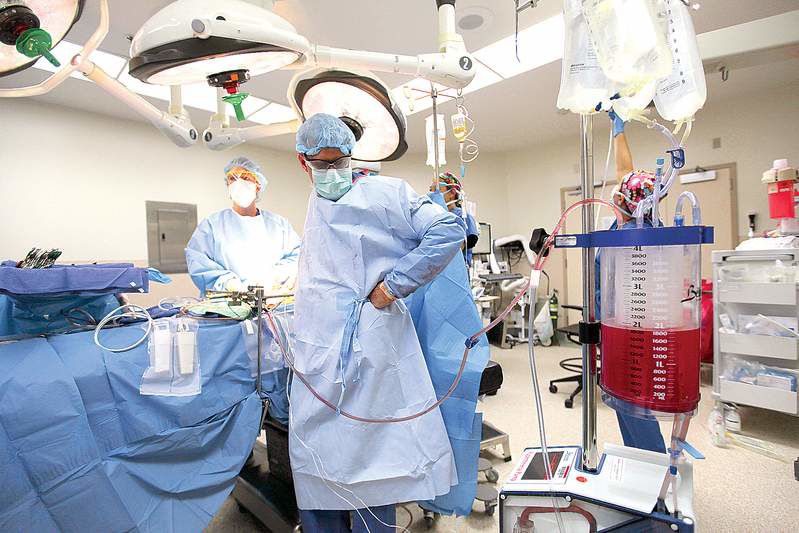Hot chemotherapy bath
Published 5:00 am Thursday, September 22, 2011

- A machine pumps heated chemotherapy directly into a patient's abdominal cavity as Dr. Andrew Lowy, left, jiggles the patient's belly to help disperse the drug. The new procedure, called Hipec, uses a technique in which inner organs are bathed and swished in hot chemotherapy. Skeptics say the costly and terribly painful procedure has not been proven to work, but it may offer a glimmer of hope for some.
SAN DIEGO — This is cancer therapy at its most aggressive, a treatment patients liken to being filleted, disemboweled and then bathed in hot poison.
The therapy, which couples extensive abdominal surgery with blasts of heated chemotherapy to the abdominal cavity and its organs, was once a niche procedure used mainly against rare cancers of the appendix. Most academic medical centers shunned it.
More recently, as competition for patients and treatments intensifies, an increasing number of the nation’s leading medical centers have been offering the costly — and controversial — therapy to patients with the more common colorectal or ovarian cancers. And some hospitals are even publicizing the treatment as a hot “chemo bath.”
To critics, the therapy is merely the latest example of one that catches on with little evidence that it really works.
“We’re practicing this technique that has almost no basis in science,” said Dr. David Ryan, clinical director of the Massachusetts General Hospital Cancer Center.
But to some patients, the procedure, however grueling and invasive, represents their best hope for survival: “It’s throwing everything but the kitchen sink at cancer,” said Gloria Borges, a 29-year-old Los Angeles lawyer who had her colon cancer treated with what she called the “pick it out, pour it in” procedure.
For hours on a recent morning at the University of California, San Diego, Dr. Andrew Lowy painstakingly performed the therapy on a patient. After slicing the man’s belly wide open, he thrust his gloved hands deep inside, and examined various organs, looking for tumors. He then lifted the small intestine out of the body to sift it through his fingers.
As he found tumors, he snipped them out. “You can see how this is coming off like wallpaper,” Lowy said as he stripped out part of the lining of the man’s abdominal cavity.
After about two hours of poking and cutting, Lowy began the so-called shake and bake. The machine pumped heated chemotherapy directly into the abdominal cavity for 90 minutes while nurses gently jiggled the man’s bloated belly to disperse the drug to every nook and cranny.
The treatment is formally called cytoreductive surgery followed by hyperthermic intraperitoneal chemotherapy, or HIPEC.
Recent converts include University Hospitals Case Medical Center in Cleveland, Montefiore Medical Center in the Bronx, and even Massachusetts General. The Memorial Sloan-Kettering Cancer Center is looking at it, according to people in the field. Advocates predict that the number of procedures could grow to 10,000 a year from about 1,500 now.
The therapy has even been featured on an episode of the TV series “Grey’s Anatomy.”
Up for debate
But Ryan, a gastrointestinal oncologist, suggested in an interview that the procedure was being extended to colorectal cancer because “you can’t make a living doing this procedure in appendix cancer patients.”
He debated the procedure publicly at the recent annual meeting of the American Society of Clinical Oncology. While some patients did seem to live much longer than expected, he said that they had been carefully selected and might have fared well even without the therapy.
Proponents say that if cancer has spread into the abdominal cavity but not elsewhere, then lives can be prolonged by removing all the visible tumor and killing what’s missed with HIPEC.
By contrast, said Dr. Paul Sugarbaker, a surgeon at Washington Hospital Center and the leading proponent of HIPEC, “there are no long-term survivors with systemic chemotherapy — zero.”
Sugarbaker, who opposed Ryan in the debate, said that it has long been known that cancerous cells are unable to withstand as much heat as healthy cells. And putting the chemotherapy on top of tumors should be more effective than systematically delivering it through the bloodstream.
One randomized trial done more than a decade ago involving 105 patients in the Netherlands did show a striking benefit. The median survival of those getting surgery and HIPEC, plus intravenous chemotherapy, was 22.3 months, almost double the 12.6 months for those getting only the intravenous chemotherapy. But 8 percent who got the surgery and HIPEC died from the treatment itself. And critics say that since that trial was conducted, new drugs have come to market that allow patients with metastatic colorectal cancer to live two years with intravenous chemotherapy alone.
A new trial in the U.S. has been temporarily suspended so that researchers can find a way to recruit patients. After nearly a year only one patient had enrolled, because people were reluctant to chance winding up in the control group, according to one of the investigators.
While proponents contend that the risk of dying from the surgery has been reduced since the Dutch trial, the procedure still lasts eight hours or more and full recovery can take three to six months. “It’s maximally invasive,” said Sugarbaker, who often removes the “spare parts” — organs a patient can live without, like the spleen, the gall bladder, the omentum, the ovaries, the uterus and maybe part of the colon.
A costly therapy
The cost of the surgery and HIPEC, including hospitalization, ranges from $20,000 to more than $100,000, doctors said. While Medicare and insurers generally pay for the operation, the heated treatment may not be covered. But doctors added it may be if it is described merely as chemotherapy. Some patients, like Borges, who is a fitness devotee, recover well and say the procedure staved off a death sentence.
But Dr. Alan Venook, a colon cancer specialist at the University of California, San Francisco, said that a couple of patients referred by him had “died miserable deaths. One lost much of her abdominal wall to infection and just died in misery.”
Another risk is that the surgery may be done unnecessarily. CT scans cannot pick up many of the small tumors, so it is often unclear how much cancer is inside until the patient is opened.
In June, Lowy sliced open a woman and saw, to his horror, that she had more tumors than he could remove. Taking out only some would not improve her chances of survival, so he closed the incision, and she is now starting intravenous chemotherapy.
Things with the male patient, Andy S., went better. A 41-year-old father of two from near San Francisco, S. agreed to let a reporter observe the surgery, but asked that his full name not be published because he did not want his cancer history to surface through Web searches.
S. had abdominal pain eventually diagnosed as appendicitis. But the appendix was found to be cancerous. Such cancers typically spew mucus containing tumor cells into the abdominal cavity. So he signed up for surgery and HIPEC with Lowy.
“I’ve had to say my goodbyes to everybody,” S. said the day before the operation. “I had to talk to my priest. I had to do all these things I never thought I’d have to do at 41. I wouldn’t wish it on my worst enemy, but I have to go through with it.”
‘Never see this again’
Lowy explored the entire cavity from the diaphragm to the pelvis. He found mucus in several spots that he sopped up with a cloth and also tiny tumors the size of a pencil eraser that had implanted in several spots. He snipped those out and sewed up the wounds. He removed the right side of the man’s colon and the omentum, a fatty structure.
Then two Y-shaped tubes hooked to the HIPEC machine were inserted into the abdominal cavity, one to deliver the chemotherapy and the other to bring the drug back to the machine to be reheated.
The incision was sewn up around the tubes so the chemotherapy would not leak.
The man’s belly was filled with three liters of saline fluid and the chemotherapy, a generic drug called mitomycin C, heated to 42 degrees Celsius, or nearly 108 degrees Fahrenheit. Any hotter could have caused injuries. Bloated with liquid, the man’s torso resembled a water bed.
After 90 minutes, the fluid was drained, the incision reopened for a final check for tumors and bleeding, before the patient was stitched up. The procedure took six hours.
“We got all of the visible disease, and he didn’t have a lot of visible disease,” Lowy said with satisfaction.
S. left the hospital eight days later, happy to have undergone the treatment.
“I want to have the best chance I can have to never see this again,” he said.
Stealth marketing by a ‘hot chemo’ company
Dr. Jason Foster, a University of Nebraska surgeon, extolled the virtues of heated chemotherapy delivered directly into the abdominal cavity in a Web presentation in June. What he did not mention was that the website on which he appeared, HipecTreatment.com, is a marketing tool for ThermaSolutions, the leading manufacturer of equipment used for the controversial treatment.
The moderator of the webcast, Glenn Keeling, is a founder and an executive at the company, though the website itself makes no mention of its connection to the company. Glenn Keeling and his brother Gary Keeling, the vice president for sales at ThermaSolutions, say they personally own the site. Still, one inducement for doctors to choose ThermaSolutions equipment is that their practices will be promoted on the website, according to doctors and industry executives.
As medical equipment goes, Hipec represents a tiny market, but one that is attracting more competitors. For example, Belmont Instrument is gaining market share at the expense of ThermaSolutions. A third company, ThermalTherapeutic Solutions, is entering the market. And even more companies are lining up.
The companies sell machines cleared by the Food and Drug Administration to circulate a heated sterile fluid through the abdomen. There are no medical claims made that this helps cancer patients.
When ThermaSolutions got its regulatory approval in 1999, it commissioned a market research study that said Hipec might be used for 20,000 cancer patients a year, Gary Keeling said.
There were only about 1,500 Hipec procedures done in the United States last year, he said.
ThermaSolutions, now based in St. Paul, has had a series of financial problems, management turnover and name changes. Keeling said the company was now owned by a Dutch holding company whose name he would not disclose.
He said ThermaSolutions’ machine was used in 68 of the roughly 80 hospitals in the United States that offered Hipec.
The biggest challenger, Belmont Instrument of Billerica, Mass., started off making equipment for the military to heat blood being transfused on the battlefield. Its machine is considerably smaller and lighter than the ThermaSolutions machine.
Lisa Fornicoia, director for sales and marketing at Belmont, said customers could buy its machine for $35,000 and then pay $410 a procedure for disposables. ThermaSolutions does not usually sell its machine, and charges something like $3,000 a procedure plus leasing fees.
Gary Keeling of ThermaSolutions declined to discuss the company’s price.
Thornton Hospital, part of the University of California, San Diego, switched to the Belmont equipment.
“In one year, we saved $50,000,” said Dr. Andrew Lowy, a surgeon who performs the procedure there.
With competition heating up, Belmont has taken a page out of its rival’s book. It has started its own website, HipecDoctor.com. The only physicians listed as offering Hipec are those who use Belmont equipment.
— Andrew Pollack, New York Times News Service






